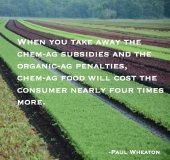
 2
2





How permies.com works
What is a Mother Tree ?
 1
1




Idle dreamer
 2
2




"You must be the change you want to see in the world." "First they ignore you, then they laugh at you, then they fight you, then you win." --Mahatma Gandhi
"Preach the Gospel always, and if necessary, use words." --Francis of Assisi.
"Family farms work when the whole family works the farm." -- Adam Klaus
 2
2




 2
2




 2
2




 2
2




paul wheaton wrote:I'm surprised anybody feels the need to ask me to source this information.
 3
3




Tyler Ludens wrote:This analysis might have some helpful numbers: http://nyu.academia.edu/KellyMoltzen/Papers/379987/Subsidies_and_Specialty_Crops_An_Analysis_of_the_Current_State_of_U.S._Agricultural_Policy
Another report looking at subsidies and prices: http://www.foodandwaterwatch.org/pressreleases/do-farm-subsidies-cause-obesity/
More dismaying numbers: http://www.pcrm.org/health/reports/agriculture-and-health-policies-unhealthful-foods
http://www.organicconsumers.org/gefood/govtsoyloans.cfm
etc etc....
"Line upon line, precept upon precept"
 1
1





Idle dreamer













Logan Simmering wrote:Where are these numbers coming from? some quick searching tells me that 5he US (grain) corn crop is worth 15.1 billion in sales and is supported by 2.8 billion in subsidies. And my understanding of the structure of us aggriculture subsidies is that removing them would cause a temporary drop in price as the loss of the price floor causes producion to expand rapidly (the old saw about paying farmers not to grow corn) in search of ever diminishing margins as more corn comes on the market, followed by huge price voltility in the long run, and chem-agg killing all the soild instead of just most of it.
 although i cant see how your logic works ?!?!! removal of 2.8 billion (18.54%) from the annual ...
although i cant see how your logic works ?!?!! removal of 2.8 billion (18.54%) from the annual ...








David Williams wrote:
Logan Simmering wrote:Where are these numbers coming from? some quick searching tells me that 5he US (grain) corn crop is worth 15.1 billion in sales and is supported by 2.8 billion in subsidies. And my understanding of the structure of us aggriculture subsidies is that removing them would cause a temporary drop in price as the loss of the price floor causes producion to expand rapidly (the old saw about paying farmers not to grow corn) in search of ever diminishing margins as more corn comes on the market, followed by huge price voltility in the long run, and chem-agg killing all the soild instead of just most of it.
Nice to see you've backed it up with verifiable statistics !! but lets use your figures ...although i cant see how your logic works ?!?!! removal of 2.8 billion (18.54%) from the annual ...
Maize (corn), U.S. No. 2 Yellow, FOB Gulf of Mexico, Price in US$ per bushel: 6.12.....As of: Friday, July 26, 2013 .....Source: USDA Market News http://www.indexmundi.com/commodities/?commodity=corn
a drop of 18.54% = $4.98 per bushel that's the price drop you mention which i do agree with ... now you say production expands quickly ? this doesn't make financial sense, farmers do not grow a product that there is no return on , they plant crops that yield higher profits to remain viable (sorghum, millet, clover/lucerne ect) ......at this point the market gets "world parity price" and imports even out the price....this is an even playing field , world parity... resulting in stability , not volatility....




 just my point of view, and lastly , i'd personally like to thank you Logan for looking a little more in-depth into something i can see you feel strongly about , through knowledge and re-evaluation of things in life is what creates change , even if we disagree as a result or reaffirm what we believed beforehand
just my point of view, and lastly , i'd personally like to thank you Logan for looking a little more in-depth into something i can see you feel strongly about , through knowledge and re-evaluation of things in life is what creates change , even if we disagree as a result or reaffirm what we believed beforehand



hate to bother you because you are busy. There is a quote of yours on Food Inc (on Facebook) about farm subsidies, and penalties for organic ag. There is a lot of noise being made by people with questionable agendas about this idea of penalties for organic ag. They say there is no such thing. I can't find anything offhand to refute them. Could you take a loot at the post and maybe say something when you get a chance. Thanks
https://permies.com/t/16161/md/Subsidies-penalties-true-cost-food
I went to google and typed in "organic certification fees" and it came
back with this as the first link:
http://www.ccof.org/certification/fees
And then to find out why those people seem to not know how to use
google, but they are very good at FUD:
https://permies.com/t/12873/tnk/professional-trolls








August Hurtel wrote:
But anyway, with a concerted effort, a consortium could push them out with competitive pricing and focusing most if not all supply to ground beef.










Skandi Rogers wrote:It's going to depend on the country. I can claim around 300 USD per hectare in subsidies just for having conventional agricultural land, but if I have Organic land then I can claim $600 per hectare (this may change since the latest budget gutted the EU's common agricultural policy)
Organic does cost more, it needs more fuel or plastic inputs, more labour, the seeds are more expensive and the paperwork is an order of magnitude higher and I expect the consultant you MUST employ costs but I can't find info on that.

|
Opportunity is missed by most people because it is dressed in overalls and looks like work - Edison. Tiny ad:
Freaky Cheap Heat - 2 hour movie - HD streaming
https://permies.com/wiki/238453/Freaky-Cheap-Heat-hour-movie
|






